Imagine having fresh, fragrant hydroponic basil at home all the time. Indoor herb gardening makes it easy to enjoy basil all year. Growing hydroponic basil is simple and ensures you always have this popular herb on hand. Just follow a few easy tips to start growing your own fresh basil.
To grow hydroponic basil, you need the right tools and growing medium. With a bit of practice and patience, you’ll soon enjoy the benefits of basil. It’s perfect for both experienced gardeners and beginners looking to add fresh flavor to their dishes.
Key Takeaways
- basil is easy to grow and requires minimal equipment
- Indoor herb gardening is a great way to have a constant supply of fresh basil
- Basil cultivation can be done year-round with the right conditions
- Hydroponic basil requires 14-16 hours of light per day for optimal growth
- The ideal temperature range for basil is between 65-80 degrees Fahrenheit
- basil has a crop cycle of approximately 28 days under optimal conditions
Table of Contents
Getting Started with Hydroponic Basil
To start growing hydroponic basil, you need to know the basics. Hydroponic systems provide a perfect environment for plants. With the right tips, you can grow a lot of basil. When starting seeds indoors, keep the temperature around 75 degrees Fahrenheit and the humidity below 60%.
After your seeds germinate, move them to a hydroponic system. Pick a good growing medium like rockwool or coco coir. Make sure your system has a pump, reservoir, and nutrient delivery system. Genovese, Elindra, and Purple Ruffles are great basil varieties for hydroponics.
Choosing the Right Seeds
Choose seeds that are made for indoor growing and germinate well. Start seeds indoors 10-14 days before moving them to your hydroponic system.
Essential Growing Mediums
Rockwool, coco coir, and peat moss are good for basil. They mix water and nutrients well for your plants.
Basic Equipment Needed
You’ll need a grow tray, reservoir, pump, and nutrient delivery system to start. You can buy these items separately or in a starter kit.
Follow these tips and use the right equipment for a thriving basil garden. Enjoy fresh herbs all year.
| Variety | Germination Rate | Maturity Days |
|---|---|---|
| Genovese | 90% | 60-70 |
| Elindra | 85% | 55-65 |
| Purple Ruffles | 80% | 65-75 |
Understanding Hydroponic Systems for Basil Growth
Exploring hydroponic gardening means learning about different systems for growing basil. These systems give plants the nutrients, water, and oxygen they need to grow well. Hydroponics can lead to more crops and use less water.
Popular systems for basil include the wick, deep water culture (DWC), and nutrient film technique (NFT). The wick system is easy and cheap, with plants getting nutrients from a reservoir. DWC suspends roots in a nutrient-rich solution. NFT feeds plants with a constant flow of nutrients.
When picking a system, think about space, budget, and upkeep. For example, the wick system is great for small areas and needs little care. But NFT is better for bigger setups and needs regular checks. Choosing the right system means you’ll get lots of fresh basil.
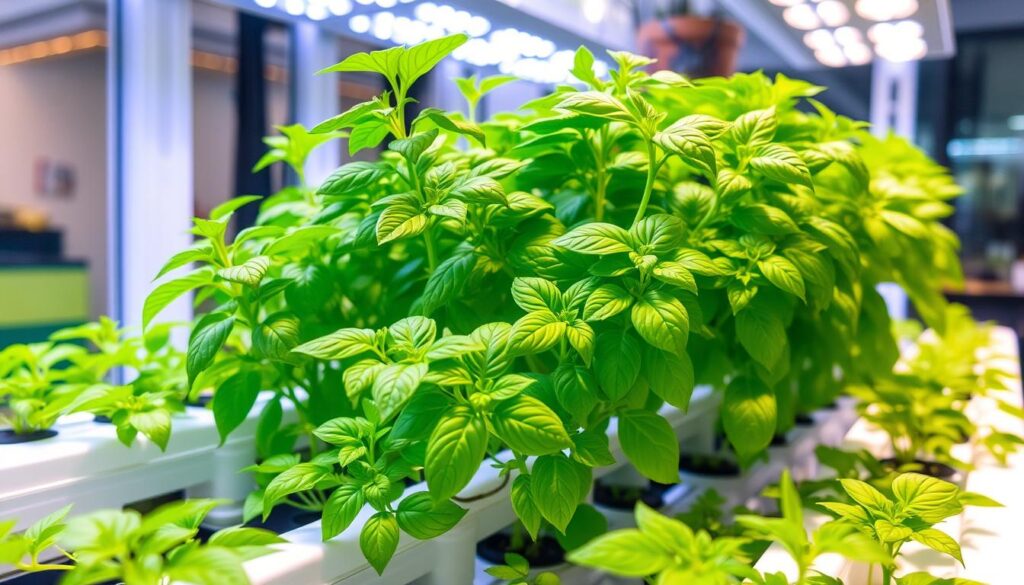
- Increased crop yields: Hydroponic systems can increase basil yields by up to 30% compared to traditional soil-based methods.
- Water efficiency: Hydroponic systems use up to 90% less water than traditional soil-based methods.
- Improved growth rates: Hydroponic systems can accelerate basil growth rates, with some systems allowing for harvest in as little as 4-6 weeks.
| Hydroponic System | Description | Benefits |
|---|---|---|
| Wick System | A simple and affordable system where the plant’s roots absorb nutrients from a reservoir through a wick. | Low maintenance, ideal for small spaces |
| Deep Water Culture (DWC) | A system where the plant’s roots are suspended in a nutrient-rich solution. | High crop yields, easy to monitor |
| Nutrient Film Technique (NFT) | A system that uses a continuous flow of nutrient solution to feed the plants. | High crop yields, suitable for large operations |
Optimal Growing Environment
To grow basil well, you need the right environment. Keep the temperature between 65–70°F (18–21°C). Also, make sure the lighting is correct. Basil needs at least 14 hours of light daily and a DLI of 12 mol per m² per day.
Water quality is key in indoor herb gardening. Basil grows best in water with a pH of 5.8 to 6.2. The Electroconductivity (EC) should be between 1.0 to 1.4 mS/cm. These conditions help basil grow healthy and strong.
Here are some important factors for growing hydroponic basil:
- Temperature: 65–70°F (18–21°C)
- Lighting: 14 hours per day, with a DLI of at least 12 mol per m² per day
- pH level: 5.8–6.2
- EC levels: 1.0–1.4 mS/cm
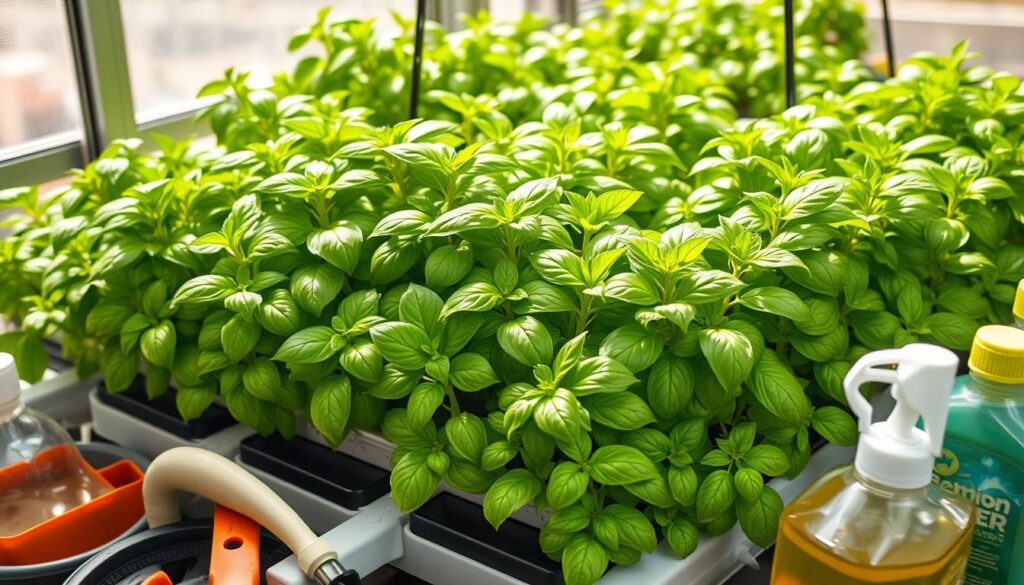
By keeping these guidelines in mind, you can have a great indoor herb garden. You’ll enjoy fresh, delicious basil.
| Factor | Optimal Range |
|---|---|
| Temperature | 65–70°F (18–21°C) |
| Lighting | 14 hours per day, with a DLI of at least 12 mol per m² per day |
| pH level | 5.8–6.2 |
| EC levels | 1.0–1.4 mS/cm |
Setting Up Your Hydroponic Garden
To start growing basil with hydroponics, you need to set up your garden. You’ll need the right equipment and some key growing tips. Choose a hydroponic method like DWC or NFT, which works well for beginners.
Think about the space and resources you have. For small spaces, a wick system or Kratky method is great. They need little care and are cost-effective. For bigger areas, an NFT system is better. It lets you grow many basil plants at once.
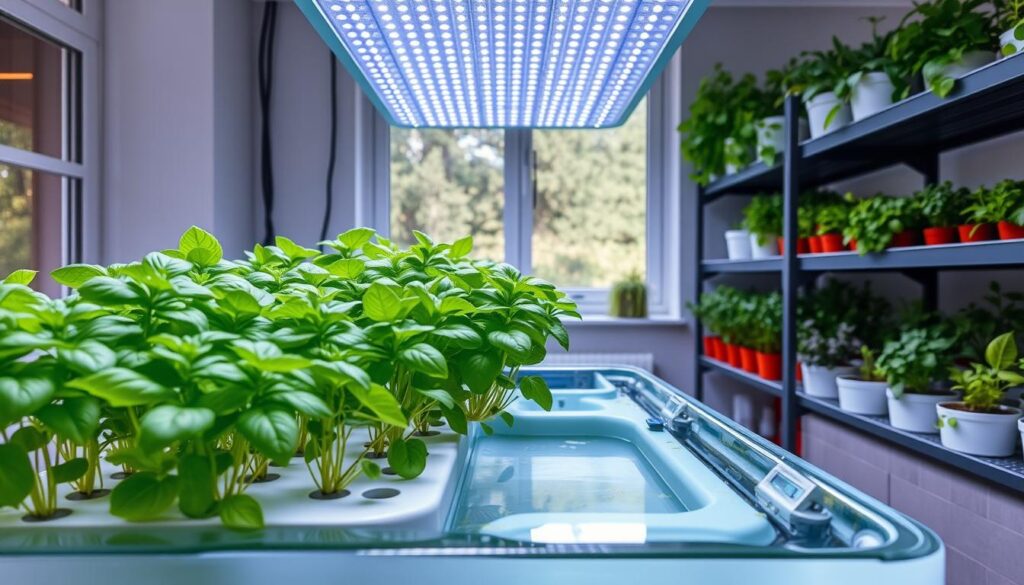
- Choosing disease-resistant seeds to increase your success rate
- Providing optimal light exposure, typically 14-16 hours per day
- Maintaining the right pH range (5.5-6.8) and EC (Electrical Conductivity) range (1.0-1.6) for optimal nutrient absorption
By following these tips and setting up your garden right, you can enjoy fresh, delicious basil all year. Hydroponic systems make it possible.
Essential Nutrients and Feeding Schedule
Hydroponic gardening needs the right nutrients for plants to grow well. For basil, a balanced diet is key. This includes primary and secondary nutrients. Primary nutrients like nitrogen, phosphorus, and potassium are vital for growth. Secondary nutrients like calcium and magnesium support this growth.
The feeding schedule is crucial in hydroponic gardening. Your basil plants need nutrients at the right time. A good hydroponic nutrient solution has an EC level of about 1.2 us/cm. Also, keep the pH level between 5.8 and 6.2 for best growth.
Primary Nutrients
Primary nutrients are the foundation of plant growth. Nitrogen helps with leaf growth, phosphorus with roots, and potassium for overall health. A balanced solution should have these nutrients in the right amounts.
Secondary Nutrients
Secondary nutrients support plant growth. Calcium is key for cell walls, and magnesium for photosynthesis. Adding these nutrients to your solution helps with healthy growth.
pH Management
pH management is vital in hydroponic gardening. The ideal pH for hydroponic basil is 5.8 to 6.2. Regular pH checks and adjustments ensure your plants get the nutrients they need.
By following a good feeding schedule and providing the right nutrients, you can grow healthy basil. Remember to check and adjust the pH level often for the best growth.
Maintenance and Care Techniques
For the best basil care, regular maintenance is key. You need to watch the water level and nutrient mix in the reservoir. Check the water level every day and add more as needed to keep your plants nourished.
Pruning is also vital for indoor basil farming. Regular pruning encourages healthy growth and stops plants from flowering. This way, you get more leaves and keep your plants working well.
Some important maintenance tasks include:
- Checking the pH level of the nutrient solution regularly
- Monitoring the temperature of the growing area
- Providing adequate lighting for your plants
By sticking to these care and maintenance tips, your basil plants will flourish. Remember to keep up with reservoir care and pruning to keep your plants healthy and productive.
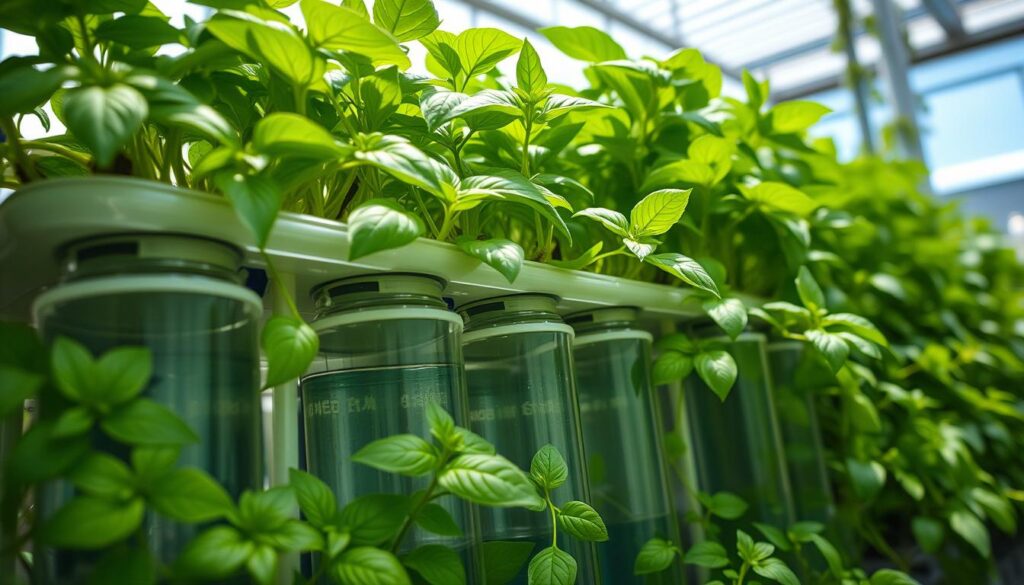
With the right care and attention, your indoor basil farming can be a hit. Remember, hydroponic basil care needs attention to detail, but the rewards are worth it.
| Maintenance Task | Frequency |
|---|---|
| Check water level | Daily |
| Prune plants | Weekly |
| Monitor pH level | Weekly |
Troubleshooting Common Problems
As you care for your hydroponic basil, you might face some common problems. These can harm your plants’ health and growth. It’s key to spot and fix these issues quickly to protect your crop. Keeping diseases at bay is a major part of hydroponic basil care.
Diseases can spread fast in hydroponic gardens, harming your whole crop. Watch your plants and system closely to catch problems early. Root rot, leaf spot, and powdery mildew are common diseases. To stop these, make sure air flows well, keep your system clean, and give your plants the best growing conditions.
Disease Prevention
To stop diseases in your hydroponic basil garden, do the following:
- Check your plants often for disease signs
- Ensure good air flow around your plants
- Keep your system clean and well-kept
- Give your plants the right temperature, light, and nutrients
Pest Control
Controlling pests is also vital in hydroponic basil care. Aphids, whiteflies, and spider mites are common pests. Use organic or integrated pest management methods. This includes introducing beneficial insects or using neem oil.

Growth Issues
Growth problems can also affect your hydroponic basil plants. Issues like nutrient deficiencies, pH imbalances, and temperature changes can occur. To solve these, make sure you provide the best growing conditions. This includes a balanced nutrient solution, the right pH levels, and controlled temperatures.
| Common Growth Issues | Causes | Solutions |
|---|---|---|
| Nutrient deficiencies | Imbalanced nutrient solution | Adjust nutrient solution to provide optimal levels of essential nutrients |
| pH imbalances | Incorrect pH levels | Adjust pH levels to optimal range (5.5-6.5) |
| Temperature fluctuations | Incorrect temperature | Adjust temperature to optimal range (65-75°F) |
Harvesting Your Hydroponic Basil
As you near the end of your basil cultivation journey, it’s essential to understand the best practices for harvesting your hydroponic basil. This stage is crucial in maintaining the quality and flavor of your herbs. When your basil is ready for harvest, you can expect to see a robust plant with a vibrant green color and a fragrant aroma.
To determine if your basil is ready, check for the following characteristics: the leaves should be a deep green color, and the plant should have reached a height of around 6-8 inches. You can start harvesting your hydroponic basil as soon as 3-4 weeks after planting, depending on the specific variety and growing conditions.
Timing Your Harvest
The timing of your harvest is critical in ensuring the quality of your hydroponic basil. It’s recommended to harvest your basil in the morning, when the plant is at its highest water content. This will help to prevent moisture loss and preserve the flavor and aroma of the herb.
Proper Cutting Techniques
To harvest your hydroponic basil, use a pair of clean scissors or pruning shears to cut the stems just above a node. This will help to promote new growth and prevent the plant from flowering. Make sure to leave at least 2-3 inches of stem intact to allow for continued growth.
Storage Methods
After harvesting your hydroponic basil, it’s essential to store it properly to maintain its freshness and flavor. You can store your basil in an airtight container in the refrigerator or freeze it for later use. Another option is to dry your basil using a food dehydrator or by tying it in small bunches and hanging it upside down in a warm, dry place.
Conclusion:
Growing hydroponic basil at home is rewarding and fun. You’ve learned the basics of indoor herb gardening. Now, you can grow a healthy hydroponic herb garden.
Make sure your basil gets the right light, temperature, and nutrients. Then, you’ll soon have fresh, tasty leaves to use.
Your hydroponic basil plants will give you lots of fresh herbs. This is great for those with little outdoor space or who want herbs all year. It’s a smart choice for indoor gardening.
Keep improving your hydroponic basil care skills. Try new things and enjoy growing your own herbs. The fresh flavors will make your cooking even better. Enjoy the journey and the delicious results!
FAQ
Does basil grow well in hydroponics?
Yes, basil grows exceptionally well in hydroponics. It’s one of the most popular herbs for hydroponic systems because it grows faster, produces more leaves, and has a richer flavor compared to soil-grown basil.
How do you keep hydroponic basil alive?
To keep hydroponic basil alive and healthy, maintain a pH level between 5.5 and 6.5, provide 12–16 hours of full-spectrum light per day, and use a well-balanced hydroponic nutrient solution. Regular pruning and proper air circulation also support vigorous growth.
Can I transplant hydroponic basil into soil?
Yes, you can transplant hydroponic basil into soil. Carefully rinse the roots, plant in well-draining soil, and keep the plant in a shaded area for a few days while it adjusts. Gradually introduce it to sunlight to avoid shock.
Why is my hydroponic basil turning yellow?
Yellowing basil leaves can be a sign of nitrogen deficiency, incorrect pH, overwatering, or poor lighting. Check your nutrient mix, adjust the pH to 5.5–6.5, and ensure the plant is getting enough light.
How much light does hydroponic basil need?
Hydroponic basil needs at least 12 to 16 hours of strong light daily. Use full-spectrum LED grow lights to mimic sunlight and ensure the lights are positioned 6–12 inches above the plant for optimal photosynthesis.
Can you plant hydroponic basil from grocery store?
Yes, you can plant hydroponic basil from the grocery store if it still has its roots. Rinse the roots gently and place the plant in a hydroponic system using a growing medium like rockwool or clay pellets. With proper care, it will continue to grow.
How long do hydroponic basil plants last?
Hydroponic basil plants can last anywhere from 3 to 6 months or longer, depending on how well they are maintained. Regular harvesting and nutrient management help extend the plant’s lifespan and productivity.
Which plant is not suitable for hydroponics?
Plants with large or deep root systems—such as carrots, potatoes, and sweet potatoes—are not suitable for hydroponics. These crops need soil to grow properly and do not adapt well to soilless environments.
Why is my hydroponic basil plant dying?
Common reasons for a dying hydroponic basil plant include nutrient deficiencies, incorrect pH levels, lack of light, root rot due to overwatering, or poor air circulation. Check your system regularly to identify and fix issues early
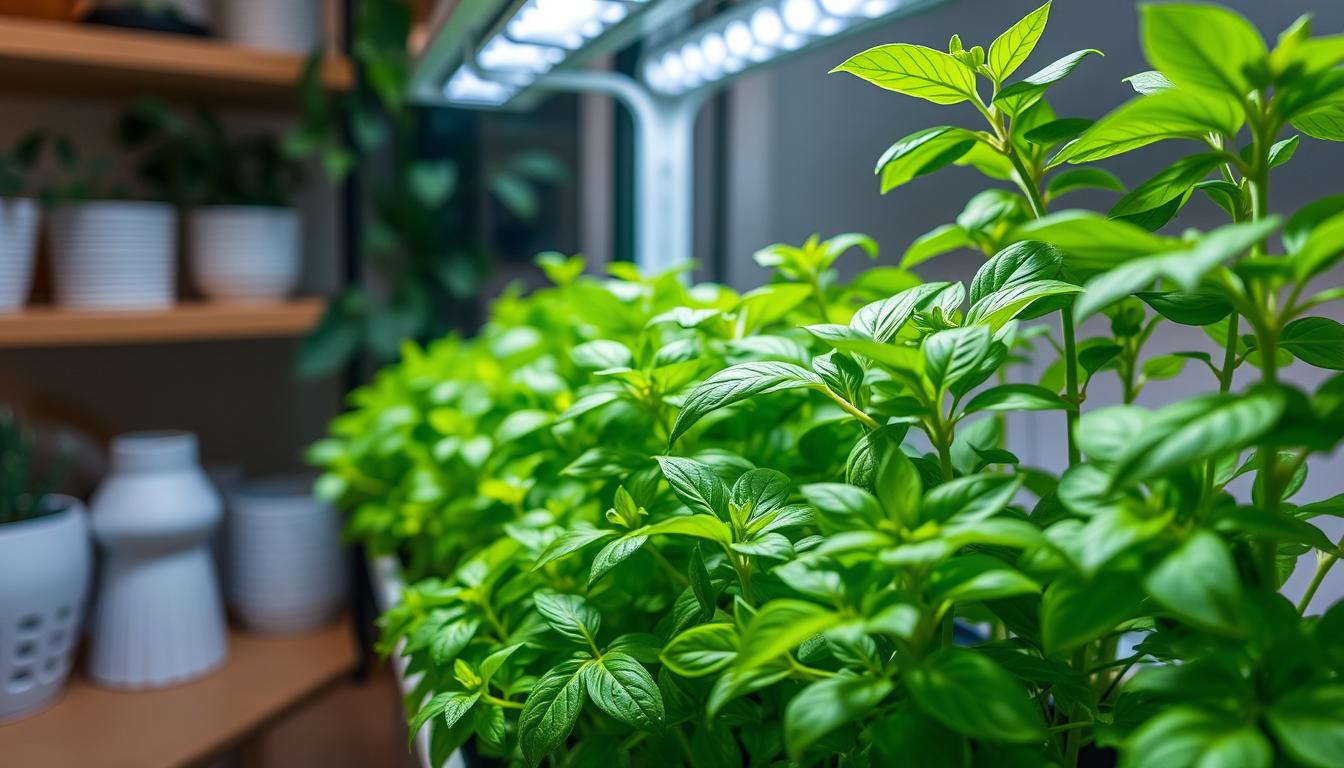
1 thought on “Hydroponic Basil at Home: Easy Tips to Grow Delicious Herbs”
Comments are closed.